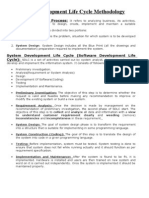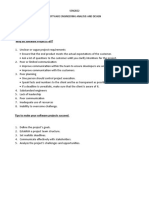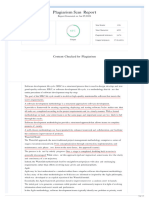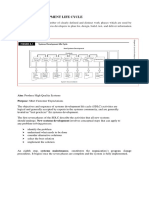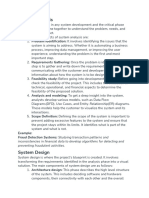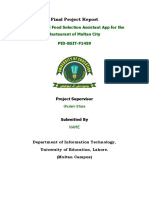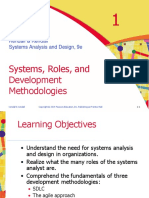Systems Development and Program
ACTIVITY No. 7
I. SDLC vs Agile methodologies in software and systems development
Explain the difference of SDLC and Agile implementation, it’s approach, advantages and
disadvantages.
SDLC and Agile are contrasting methodologies in software development. SDLC, a linear
approach, emphasizes structured phases like requirements gathering, design, coding, testing,
and maintenance, making it less adaptable to change once a phase is complete. Agile, however,
is iterative and flexible, focusing on collaboration, incremental progress, and quick response to
evolving customer needs. SDLC offers stability and systematic processes but lacks flexibility,
while Agile provides adaptability and faster development cycles but requires active stakeholder
involvement and may pose challenges in estimating timelines and costs accurately. The choice
between SDLC and Agile depends on project requirements, complexity, and the desired level of
flexibility.
II. Systems Analysis
Consider the following dialogue between a system professional, Joe Pugh, and a manager of a
department targeted for a new information system, Lars Meyer:
Pugh: The way to go about the analysis is to first examine the old system, such as reviewing key
documents and observing the workers perform their tasks. Then we can determine which aspects are
working well and which should be preserved.
Meyer: We have been through these types of projects before and what always ends up happening is
that we do not get the new system we are promised; we get a modified version of the old system.
Pugh: Well, I can assure you that will not happen this time. We just want a thorough understanding of
what is working well and what is not.
Meyer: I would feel much more comfortable if we first started with a list of our requirements. We should
spend some time up-front determining exactly what we want the system to do for my department. Then
you systems people can come in and determine what portions to salvage if you wish. Just don’t
constrain us to the old system!
Required:
a. Obviously, these two workers have different views on how the systems analysis phase should
be conducted. Comment on whose position you sympathize with the most.
b. What method would you propose they take? Why?
I side with Lars Meyer's stance, which prioritizes starting with a comprehensive list of
requirements to precisely define the new system's purpose for his department. This ensures
clarity in desired outcomes and alignment with specific departmental needs. In contrast, Joe
Pugh's approach begins with evaluating the existing system to identify components worth
retaining. While this offers insights into effective functionalities, it may not fully address the
department's specific requirements and could lead to a modified version of the old system
rather than a genuinely enhanced one.
In navigating differing perspectives between Lars Meyer and Joe Pugh regarding system
development, a hybrid approach emerges as the optimal solution. Meyer's emphasis on
comprehensive requirement gathering at the onset ensures a clear understanding of the
department's needs, laying a solid foundation for the new system. Conversely, Pugh's
inclination to evaluate the existing system provides valuable insights into effective
functionalities but risks perpetuating outdated processes. To reconcile these viewpoints, an
approach blending both methods is proposed. This hybrid approach begins with meticulous
requirement gathering to define desired functionalities and outcomes. This ensures alignment
� Systems Development and Program
ACTIVITY No. 7
with the department's needs and avoids constraints imposed by the old system. Subsequently,
an examination of the existing system identifies valuable components that can enhance the new
system. By merging upfront requirement gathering with an assessment of the old system, this
approach strikes a balance between preserving effective components and addressing specific
departmental needs, fostering innovation while maintaining practicality.
III. Systems Design
Robin Alper, a manager of the credit collections department for ACME Building Supplies, is extremely
unhappy with a new system that was installed 3 months ago. Her complaint is that the data flow from
the billing and accounts receivable departments are not occurring in the manner originally requested.
Further, the updates to the database files are not occurring as frequently as she had envisioned. Thus,
the hope that the new system would provide more current and timely information has not materialized.
She claims that the systems analysts spent 3 days interviewing her and other workers. During that time,
she and the other workers thought they had clearly conveyed their needs. She feels as if their needs
were ignored and their time was wasted.
Required:
a. What went wrong during the systems design process?
b. What suggestions would you make for future projects?
Several issues arose during the systems design process, leading to Robin Alper's
dissatisfaction with the new system. These issues included potential miscommunication or
misunderstanding between systems analysts and the credit collections department, inadequate
documentation of requirements, and insufficient testing and validation before implementation.
To prevent similar problems in the future, it's crucial to enhance communication and
collaboration, thoroughly gather and document requirements, conduct robust testing, provide
regular progress updates to stakeholders, and establish post-implementation support and
feedback mechanisms. These measures aim to improve project outcomes by ensuring better
alignment with departmental needs and expectations, ultimately leading to the successful
delivery of systems that meet the organization's goals and requirements.
In addition to the aforementioned issues during the systems design process, other
factors contributing to Robin Alper's dissatisfaction with the new system may include a lack of
involvement or feedback from end-users during the development phase and inadequate training
or support provided to the credit collections department upon system implementation. To
address these concerns, it's essential to prioritize user involvement and feedback throughout
the project lifecycle, ensuring that end-users' perspectives and needs are incorporated into the
system design and development process. Furthermore, providing comprehensive training and
ongoing support to departmental staff post-implementation can help mitigate challenges
associated with transitioning to the new system and facilitate smoother adoption and utilization.
These strategies, coupled with improved communication, documentation, and testing practices,
can significantly enhance the success and satisfaction of future system development projects.
IV. Scope Creep
Scope creep refers to the gradual and uncontrolled expansion of a project's boundaries beyond its
initial limits. It occurs when new requirements, features, or deliverables are continuously added without
proper consideration of their impact on time, resources, and budget. This phenomenon can have
significant negative effects on project implementation, including delays, increased costs, resource
strain, decreased productivity, and compromised quality of deliverables. It can also lead to
dissatisfaction among stakeholders and a misalignment with the project's original objectives. To
address scope creep, effective change management processes should be established, such as clearly
defining project scope, implementing formal change control procedures, conducting impact
assessments, and maintaining regular communication with stakeholders. These measures help project
� Systems Development and Program
ACTIVITY No. 7
teams manage scope changes proactively and ensure successful project implementation within defined
constraints.
.
V. Audit of Systems Development
The Balcar Company’s auditors are developing an audit plan to review the company’s systems
development procedures. Their audit objectives are to ensure that:
1. The system was judged necessary and justified at various checkpoints throughout the SDLC.
2. Systems development activities are applied consistently and in accordance with management’s
policies to all systems development projects.
3. The system as originally implemented was free from material errors and fraud.
4. System documentation is sufficiently accurate and complete to facilitate audit and maintenance
activities.
The following six controllable activities have been identified as sources of audit evidence for
meeting these objectives: systems authorization, user specification, technical design, internal audit
participation, program testing, and user testing and acceptance.
Required:
a. Explain the importance of each of the six activities in promoting effective control.
b. Outline the tests of controls that the auditor would perform in meeting audit objectives.
Each of the six identified activities – systems authorization, user specification, technical
design, internal audit participation, program testing, and user testing and acceptance – plays a
pivotal role in ensuring effective control in The Balcar Company's systems development
procedures. Systems authorization verifies project necessity and justification, preventing
unnecessary resource allocation. User specification ensures that the system is tailored to meet
the specific needs of both the organization and its users. Technical design promotes
consistency and standardization in implementation. Internal audit participation offers an
independent assessment of controls and compliance. Program testing ensures the accuracy
and reliability of system operations, while user testing and acceptance prioritize user
involvement and satisfaction.
Moreover, comprehensive system documentation is essential for facilitating audit and
maintenance activities, enabling auditors to understand the system's design, functionality, and
controls. By conducting tests of controls for each activity, auditors can gather evidence to
assess whether the audit objectives are met, thereby reinforcing effective control in the systems
development process. Additionally, regular communication and collaboration among
stakeholders throughout the development lifecycle are crucial for maintaining alignment with
organizational objectives and ensuring successful system implementation.









